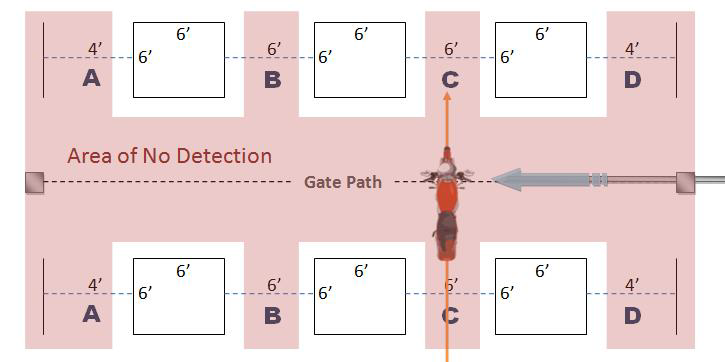Educational Articles
Debunking Multi-Loop Configurations
Loops are installed to detect vehicles and to prevent the gate or vehicle barrier arm from coming in contact with vehicles. Multi-loop configurations (using multiple 6’x6’ loops spaced 6’ apart to span a wide drive way in replace of one larger loop) leave detection gaps that can allow smaller vehicles such as motorcycles to pass by undetected, which defeats the purpose of installing loops in the first place.
Ask yourself, who is likely to take more damage from coming in contact with a gate: a person in a car or a person on a motorcycle?
There are manufacturers that recommend multi-loop configurations be used to cover wide gate paths. For a long time multi-loop configurations were considered to be an accepted industry standard, unfortunately that does not mean that the practice is truly acceptable or safe.
We have found in our testing when the detector is set to max sensitivity the best case scenarios for motorcycle detection on a 6’x6’ multi-loop configuration would be as follows: the motorcycle can be detected on the sides of the loop up to 18” away when the loops were out of phase, or up to 12” away when the loops are in phase.

This means with the multi-loop configuration we tested the areas (or gaps) where detection is unlikely to occur ranges from 29%-37% of the driveway width, again this is with the detector set to the highest sensitivity level, on a lower sensitivity level the undetectable area increases substantially.
Example of detection gaps in a practical application:

In today’s litigious society multi-loop configurations are a liability. Multi-loop configurations have a much higher chance of not detecting a motorcycle than a single loop configuration. For this reason alone they should be warned against. Using multi-loop configurations will increase the likelihood that someone is going to be hurt by a gate or barrier arm.
Concern about detecting motorcycles and other types of smaller vehicles (scooters, golf carts, etc.) is also the reason BD Loops recommends that the stand-off distance from the curb be 2’ or less. In our testing the furthest distance where the motorcycle was detected on the side of a loop was 12”. This means that with a 4’ curb standoff distance there is at least3’ of undetectable area where a motorcycle or scooter can squeeze by undetected. A motorcyclist is most likely to hug the curb when they are trying to make a turn or if they are trying to race a closing gate which could end in disaster if their motorcycle isn’t detected. View the Don’t Get Caught Short in Your Reverse Loop Design write up on BDLoops.com “Education & More” page to see why curb standoff distances should always be 2’ or less.
A single large loop configuration provides a more reliable means of motorcycle detection than a multi-loop configuration. With a single large loop and an appropriate detector there are no detection gaps where a small vehicle such as a motorcycle can pass by undetected.
Example of detection gaps in a large single loop application:

Besides the detection advantage, installing a large loop is physically easier on the installer. Cutting in multi-loop configurations and wiring the loops in series to a detector, or connecting the loops to individual detectors and harness wiring them to the operator takes much longer and offers no real advantage when detection gaps are present that represent a liability to the installer.
Now you may be wondering how large can you make a loop. There are no hard rules when it comes to how large a loop can be, every installation will be different. At BD Loops we regularly make loops up to 112’ in perimeter (6’x50’), but we have made even larger loops for special applications where small vehicles such as motorcycles and golf carts would never be using the gate.
BD Loops
The Loop Experts!
BD Loops was founded in 2001. Their preformed loops and accessories are designed with the installer in mind. BD Loops offers a complete loop system solution including preformed direct burial loops, preformed saw-cut loops, loop sealant, blades, testing devices, and installation tools. BD Loops has a reputation for reliability and ease of installation. They pride themselves on the quality of their products and their commitment to providing excellent customer service and support. BD Loops preformed loops are made in the USA at their facility in Placentia, CA.

